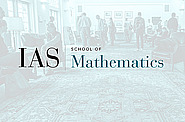Seminars Sorted by Series
Computer Science/Discrete Mathematics Seminar II
Apr
19
2011
Apr
26
2011
May
03
2011
Computer Science/Discrete Mathematics Seminar II
CSDM Seminars II will be resume first term of the 2011-12 academic year
10:30am|S-101
Sep
20
2011
Computer Science/Discrete Mathematics Seminar II
Existence of Small Families of t-wise Independent Permutations and t-Designs Via Local Limit Theorems
10:30am|S-101
Sep
27
2011
Computer Science/Discrete Mathematics Seminar II
Tight Lower Bounds for 2-query LCCs Over Finite fields
10:30am|S-101
Oct
04
2011
Computer Science/Discrete Mathematics Seminar II
Limit Theories and Higher Order Fourier Analysis
10:30am|S-101
Oct
11
2011
Computer Science/Discrete Mathematics Seminar II
Limit Theories and Higher Order Fourier Analysis
10:30am|S-101
Oct
18
2011
Computer Science/Discrete Mathematics Seminar II
Rigidity of 3-Colorings of the d-Dimensional Discrete Torus
Ohad Feldheim
10:30am|S-101
Oct
25
2011
Nov
01
2011
Computer Science/Discrete Mathematics Seminar II
No seminar
No Seminar (CCI Quantum Computation Workshop)
10:30am|S-101
Nov
08
2011
Computer Science/Discrete Mathematics Seminar II
Vertex Sparsification: An Introduction, Connections and Applications
10:30am|S-101
Nov
15
2011
Computer Science/Discrete Mathematics Seminar II
Vertex Sparsification: An Introduction, Connections and Applications
10:30am|S-101
Nov
22
2011
Computer Science/Discrete Mathematics Seminar II
Shorter Long Code and Applications to Unique Games
10:30am|S-101
Nov
29
2011
Computer Science/Discrete Mathematics Seminar II
Shorter Long Code and Applications to Unique Games
10:30am|S-101
Dec
06
2011
Computer Science/Discrete Mathematics Seminar II
Can the Continuum Problem be Solved?
Menachem Magidor
10:30am|S-101
Dec
13
2011
Computer Science/Discrete Mathematics Seminar II
Time-Space Tradeoffs in Resolution: Superpolynomial Lower Bounds for Superlinear Space
10:30am|S-101
Jan
24
2012
Computer Science/Discrete Mathematics Seminar II
A Tutorial on the Likely Worst-Case Complexities of NP-Complete Problems
10:30am|S-101
Jan
31
2012
Computer Science/Discrete Mathematics Seminar II
A Survey of Lower Bounds for the Resolution Proof System
10:30am|S-101
Feb
07
2012
Feb
14
2012
Feb
21
2012
Computer Science/Discrete Mathematics Seminar II
Finding Needles in Exponential Haystacks
10:30am|S-101
Feb
28
2012
Computer Science/Discrete Mathematics Seminar II
Complexity, Approximability, and Mechanism Design
Christos Papadimitriou
10:30am|S-101
Mar
06
2012
Mar
13
2012
Computer Science/Discrete Mathematics Seminar II
Applications of FT-Mollification II
10:30am|West Bldg. Lecture Hall
Mar
20
2012
Computer Science/Discrete Mathematics Seminar II
The Quasi-Polynomial Freiman-Ruzsa Theorem of Sanders
10:30am|S-101
Mar
27
2012
Apr
03
2012
Computer Science/Discrete Mathematics Seminar II
Better Pseudorandom Generators from Milder Pseudorandom Restrictions
Parikshit Gopalan
10:30am|S-101
Apr
10
2012
Apr
17
2012
Apr
24
2012
Computer Science/Discrete Mathematics Seminar II
Pseudorandom Generators for Read-Once ACC^0
10:30am|S-101
May
01
2012
Computer Science/Discrete Mathematics Seminar II
Lower Bounds for Matching Vector Codes
Abhishek Bhowmick
10:30am|S-101
May
08
2012
May
15
2012
Computer Science/Discrete Mathematics Seminar II
From Irreducible Representations to Locally Decodable Codes
10:30am|West Bldg. Lecture Hall
May
22
2012
Sep
25
2012
Computer Science/Discrete Mathematics Seminar II
Koiran + Geometric Topology implies "Knottedness is in NP"
Greg Kuperberg
10:30am|S-101
Oct
02
2012
Computer Science/Discrete Mathematics Seminar II
Plug your ears! Graph isomorphism, siren of the algebraic seas, calls to your quantum helmsman.
Alex Russell
10:30am|S-101
Oct
09
2012
Computer Science/Discrete Mathematics Seminar II
On the Conjectures of Nonnegative $k$-Sum and Hypergraph Matching
10:30am|S-101
Oct
16
2012
Computer Science/Discrete Mathematics Seminar II
On the AND- and OR-Conjectures: Limits to Efficient Preprocessing
10:30am|S-101
Oct
23
2012
Nov
06
2012
Computer Science/Discrete Mathematics Seminar II
Games, Solution Concepts, and Mechanism Design: A Very Short Introduction
10:30am|S-101
Nov
20
2012
Computer Science/Discrete Mathematics Seminar II
On the Complexity of Matrix Multiplication and Other Tensors
Joseph Landsberg
10:30am|S-101
Nov
27
2012
Computer Science/Discrete Mathematics Seminar II
Computational Complexity in Mechanism Design
10:30am|S-101
Dec
04
2012
Dec
11
2012
Dec
18
2012
Computer Science/Discrete Mathematics Seminar II
The SOS (aka Lassere/Positivestellensatz/Sum-of-Squares) System
(1) Raghu Meka and (2) Avi Wigderson
10:30am|S-101
Jan
15
2013
Computer Science/Discrete Mathematics Seminar II
OSNAP: Faster Numerical Linear Algebra Algorithms Via Sparser Subspace Embeddings
10:30am|S-101
Jan
22
2013
Computer Science/Discrete Mathematics Seminar II
Sparsity Lower Bounds for Dimensionality Reducing Maps
10:30am|S-101
Jan
29
2013
Feb
05
2013
